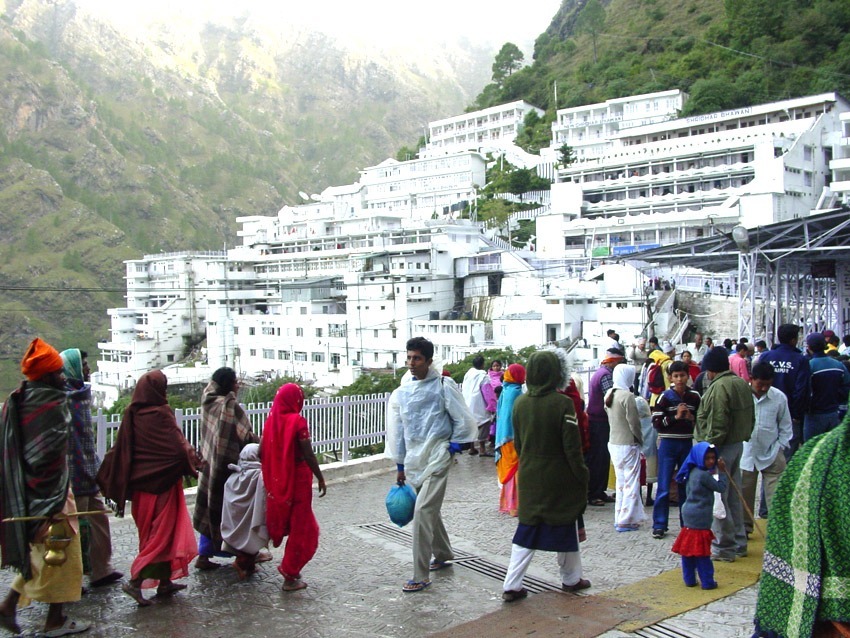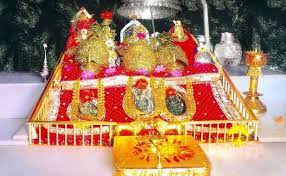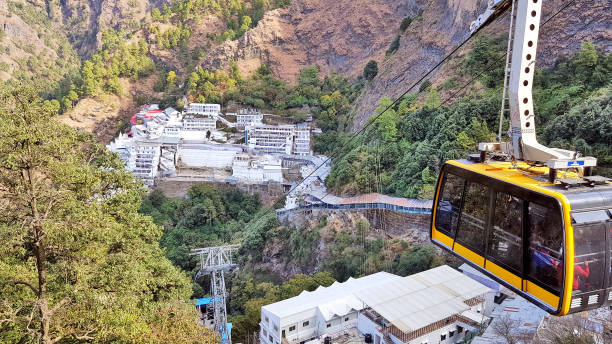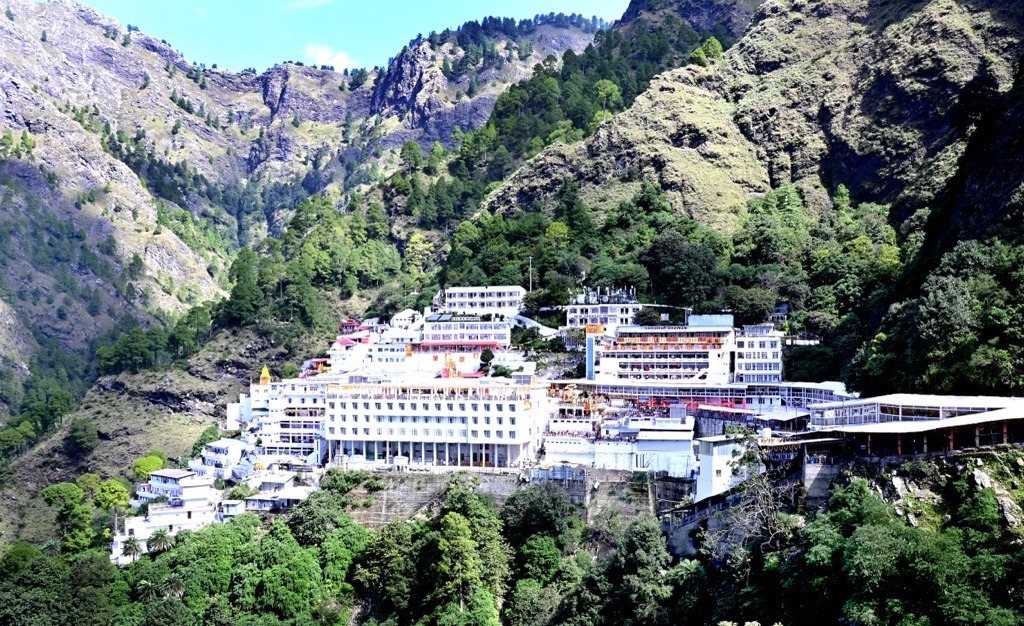
Vaishno Devi Temple, Katra
Visit Mata Vaishno Devi, a place of great spiritual importance where many people find solace and peace. Each year, countless visitors come here seeking spiritual growth and inner calmness. Tucked away in serene surroundings, it’s a special place that welcomes everyone, offering a journey that goes beyond just a visit – it’s an opportunity to discover inner peace and personal enlightenment.
Namaste 🙏 नमस्ते
Secure your visit • अपनी यात्रा सुरक्षित करें
Historical background and Architectural splendor
The history of Vaishno Devi Temple dates back to ancient times, shrouded in mythological legends and stories. It is believed that the goddess chose this sacred cave in the Trikuta Mountains as her abode. The legend narrates the tale of a young Vaishno, who undertook a penance to attain divine powers. The goddess decided to reside in the cave, where she transformed into a stone form to meditate and answer the prayers of her devotees.

Religious Significance
Embarking on the pilgrimage to Vaishno Devi transcends the physical journey, evolving into a spiritual sojourn that surpasses the confines of worldly existence. The profound spiritual significance of this pilgrimage manifests in various dimensions. The challenging trek through the mountains and the act of surrendering to the divine within the cave are perceived as transformative experiences, serving to purify the soul. Pilgrims view this arduous journey as a test of faith and determination, a symbolic purification process. Central to the pilgrimage is the earnest quest for the blessings of Goddess Vaishno Devi. Devotees undertake this spiritual odyssey to seek divine favor for health, prosperity, and overall well-being. The transformative power attributed to the goddess becomes a driving force, instilling unwavering faith in pilgrims as they navigate the demanding trek. Beyond seeking blessings, the pilgrimage serves as a platform for the renewal of faith. Devotees, surrounded by serene landscapes, engage in rituals and prayers that foster a conducive environment for spiritual introspection. This sacred endeavor becomes an opportunity for individuals to strengthen their connection with the divine, fostering a renewed sense of faith and spiritual vitality. The Vaishno Devi Yatra also holds significance as a means of karma cleansing. Many pilgrims perceive the journey as a pathway to absolve themselves of past sins and negative karma. The physical and mental challenges encountered along the way are embraced as a form of penance, contributing to the purification of the pilgrims' karma and providing a transformative aspect to their spiritual journey.


Festival and Celebrations
Here the festivals celebrated are Navratri, Sharad Navratri, Chaitra Navratri, Holika Dahan, Diwali (Deepavali), Sharad Purnima, Kartik Purnima, Vaishno Devi Jayanti, New Year Celebrations (Nav Samvatsar) and Maha Shivaratri.
Surroundings area & attractions
- Ardhkuwari Temple:A sacred spot located on the route to Vaishno Devi, known for the cave where Mata Vaishno Devi meditated for nine months.
- Bhairon Temple: For the more adventurous pilgrims, this temple is situated at a higher altitude and can be reached after the main pilgrimage to Vaishno Devi.
- Sanjichhat: A picturesque spot offering panoramic views of the surrounding mountains. Pilgrims often take a helicopter ride from Katra to Sanjichhat.
- Baba Dhansar :About 15 km from Katra, this site is famous for a temple dedicated to Lord Shiva and a beautiful waterfall.
- Shiv Khori : Located about 70 km from Katra, it's known for a naturally formed Shiva Lingam and is visited by devotees.
- Himkoti : A charming location with a small temple dedicated to Goddess Vaishno Devi, offering a pleasant stopover during the pilgrimage.
- Nau Devi Cave Temple : A cluster of nine naturally formed caves, each representing a different goddess.
FAQ
Mata Vaishno Devi Temple is located in the Trikuta Mountains in the Indian state of Jammu and Kashmir, near the town of Katra.
Mata Vaishno Devi is a manifestation of the Hindu goddess Mahalakshmi, Mahakali, and Mahasaraswati. She is revered as the Mother Goddess or Mata, and her temple is one of the most visited pilgrimage sites in India.
Mata Vaishno Devi Temple is considered one of the holiest Hindu temples, attracting millions of devotees each year. It is believed that Mata Vaishno Devi fulfills the wishes of her devotees who visit her shrine with pure hearts.
Pilgrims usually reach Katra, the base camp for the pilgrimage, either by road or by train. From Katra, they embark on a trek of approximately 13 kilometers to reach the temple, or they can opt for helicopter services.
The trek to Mata Vaishno Devi Temple from Katra is approximately 13 kilometers long and it takes 4 to 6 hours.The difficulty level of the trek varies, with some sections being steep and challenging.
Yes, there are several facilities available along the trek route, including resting places, refreshment stalls, medical aid centers, and accommodation options for those who wish to break their journey.
Apart from trekking, pilgrims can also opt for helicopter services from Katra to Sanjichhat, ponies and palanquins are available for those who may find it difficult to trek on foot.
The temple is open for pilgrimage throughout the year. However, the months of March to October are considered more favorable due to the milder weather conditions. The Navratri festival, celebrated in September/October, is a particularly auspicious time to visit
.
Various rituals and ceremonies are performed at the temple to worship Mata Vaishno Devi, including aarti (ritual of worship with lamps), bhajans (devotional songs), and offerings of flowers and prasad (sacred food).
Pilgrims can obtain the yatra slip from the Yatra Registration Counter in Katra.
Photography and videography are generally not allowed inside the sanctum sanctorum of Temple. However, photography is permitted in certain designated areas outside the temple premises.
The shrine board and local authorities implement various safety measures to ensure the well-being of pilgrims during the trek. These measures include maintaining well-marked trails, providing medical assistance along the route, and deploying security personnel for crowd management.
The cave inside Mata Vaishno Devi Temple is believed to be the holy abode of Mata Vaishno Devi. It is known as the Holy Cave or Bhawan, and pilgrims visit this cave to seek the blessings of the goddess. The cave houses the natural rock formations representing the three goddesses: Mahakali, Mahalakshmi, and Mahasaraswati.
Yes, elderly and physically challenged pilgrims can visit Mata Vaishno Devi Temple with the help of palanquins or ponies and battery-operated vehicles are available.
Some nearby tourist attractions include Banganga Temple, Ardh Kuwari Cave, Bhairon Temple, and the holy town of Katra. These sites offer additional opportunities for spiritual exploration and sightseeing.
Pilgrims are advised to maintain cleanliness, respect the sanctity of the temple, and adhere to the rules and regulations set by the shrine board. It is customary to offer prayers, perform parikrama (circumambulation) of the Holy Cave, and participate in aarti ceremonies to seek the blessings of Mata Vaishno Devi.
Visitor information
Darshan Days- All days
Address:
Notable Events and Incidents
- Renovation and Development - In 1986
- Introduction of Helicopter Services In 1991
- Mata Vaishno Devi Ardhkuwari Cave Incident 1999
Connectivity :
- By Air: Located at a distance of 50 kms, the Jammu airport is the nearest to Katra.
- By Train:The nearest railway station from Katra is the Udhampur railway station.
- By Bus: Jammu and Kashmir State Road Transport Corporation buses operate to and from Jammu to Katra at regular intervals.
